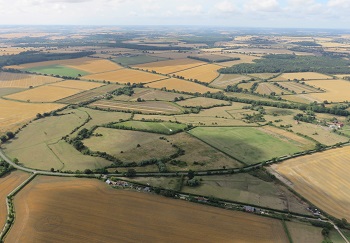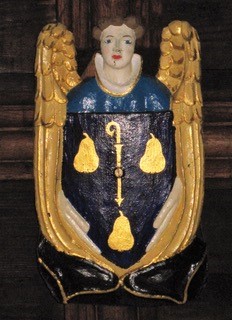Wardon Abbey 1135-1537
This page was written by Margaret Roberts, Volunteer Historian, Warden Abbey Vineyard
Foundation and expansion
Wardon Abbey was founded late in the reign of Henry I (probably 1135) by local lord of the manor, Walter Espec. Known as St Mary de Sartis, the monastery was populated by Abbot Simon and monks from the Cistercian abbey of Rievaulx (N. Yorks). Wardon flourished, and in 1147 monks were despatched to populate Sawtry Abbey (Hunts), followed by Sibton Abbey (Suffolk) in 1150. Wardon’s third daughter house, Tilty Abbey (Essex), was established in 1153.
Wardon Abbey acquired extensive landholdings in the 12th century, and by 1161 assets included the ‘great garden of Wardon’ (at least 273 acres) with a large, spring fed fishpond which served as the monastery’s reservoir. On 11 November 1198 Richard I issued a charter confirming that the monks held the site on which the abbey was situated, lands in Southill, Stanford and Chicksands, the Bedfordshire granges of Rowney, Park, Limbersey, Renhold, Putnoe with land in Milton [Ernest], and Millbrook with land in Priestley; land in Dunton was managed from Odsey Grange (Cambs). Further afield were the granges of West Wardon (Northants), Livermere (Suffolk), Burden with land in Linton (Cambs), Bradfield with Fildene Wood (Herts), and Midloe Grange (Hunts). Beside Midloe Grange lay Ravenshoe, 100 [notional] acres of woodland granted by King Stephen, which the monks had cleared for cultivation. For details see THE MANORS OF WARDON, OLD WARDEN, BEDFORDSHIRE and WARDON ABBEY 1135-1537.
Landholding could prove contentious, and in 1217 the squires of Falkes de Bréauté, sheriff of Bedfordshire and Buckinghamshire, attacked the abbey of Wardon after quarrelling over a wood. They killed one of the monks, wounded others and had about thirty of them ‘unceremoniously dragged through the mud' to Bedford Castle. The matter was resolved at a meeting in the abbey’s chapter house where de Bréauté apologised, acknowledged the monks’ right to the woodland, and did penance.
In 1224 the monks sustained significant losses from Putnoe Wood when forces of Henry III commandeered timber in preparation for the siege of Bedford Castle. The treasurer and chamberlains of the exchequer were ordered to pay twenty marks annually to the abbot of Wardon for damages, recompense that was to continue until such time as the king provided the abbot with land to the value of £10 a year; it took more than a century for the matter to be concluded.
By 1291 the monks of Wardon were renting out arable land, mills and woodland rights, selling produce and livestock, and taking revenue from manorial courts. The abbey held urban properties in Bedford, Cambridge, London and [King’s] Lynn, and at £257 0s 7½d annually, its taxable income was significantly higher than that of Woburn Abbey, which amounted to £164 15s 8¼d.
The abbey precinct and buildings
The perimeter of the monks’ land in the parish of [Old] Warden originally extended to about 6½ miles, making a series of physical boundaries (ditches, earth banks and stone walls) a priority. Early efforts would have centred around the church, claustral buildings and supporting infrastructure, and it is likely that the final sections were installed during the abbacy of Adam (c. 1232-1242). The average Cistercian precinct covered about 25 acres, but with two miles of earthworks encircling an area of 157 acres, the precinct at Wardon was probably the largest in Britain. Movement around the marshy landscape proved challenging, and causeways were constructed to facilitate access between key points.

Site and precinct of Wardon Abbey (2018) (Image copyright M. Roberts/Helicopter pilot M. Bird)
Constructed in stone during the mid-12th century, the abbey church on the north side of the cloister garth boasted an aisled nave 180 feet in length, north and south transepts with side chapels to the east, and a box-like presbytery. The cloister garth and surrounding buildings were set out according to Cistercian norms. Abutting the east side of the complex, the monks’ infirmary hall overlooked gardens, vines and fishponds, while a detached ancillary range (bakehouse, brewhouse and kiln house) lay about 50m west of the monastery.
On the back of a thriving wool business, the monks initiated a project in the late 13th or early 14th century to extend the east end of the abbey church. The result appears to have been a spectacular building some 100m in length with an aisled presbytery of seven bays covered by high-quality, glazed floor tiles fired onsite. A number of specially shaped tiles are on permanent display at The Higgins, Bedford [as of 2023].

Floor tile [ref: CRT130WAR18]
Relationship with the parish church of St Leonard, Old Warden
Walter Espec granted the advowson (the right to nominate the parish priest) to the abbey before 1154, but his charter has been lost. Although only responsible for the chancel until the third quarter of the 14th century, the monks diverted some of the workforce and resources from the abbey church project, not only to rebuild the chancel and chancel arch at the parish church, but also to add the south aisle, and install the highly unusual, 12-sided font. Of the eight corbels carved to support the new nave roof between about 1307 and 1324, six survive in situ.
On 12 November 1376 the abbot paid 40 marks to Edward III for a licence to appropriate the parish church. The strengthening of ties was marked with at least one new bell cast in the foundry of John Rufford at Toddington, and the insertion of one or more windows in the north wall of the nave during 1380/81. Depicting Abbot Walter Clifton praying to St Martha, the easternmost window is the only surviving example of a Cistercian abbot in medieval English stained glass.
1429 Right to wear pontifical insignia
In 1429 Pope Martin V granted Abbot William II of Wardon the right to wear items of pontifical insignia and to give solemn benediction on certain occasions. The British Museum houses three exquisite morses (clasps) from Wardon, which it dates to 1426/75. Used to fasten an ecclesiastical cloak, they may have been commissioned to mark the abbot’s new privileges, and represent some of the most exciting examples of Cistercian metalwork to have survived anywhere in the world.
The arms of Wardon Abbey

Arms of Wardon Abbey on a C15 roof boss in the north aisle of Ampthill parish church (Image copyright M. Roberts)
Three golden pears on a blue background, sometimes seen with a crozier, were adopted for arms of Wardon Abbey during the mid-15th century. The earliest known surviving example is found on one of the three morses and another, from about the same period, can be seen on a roof boss at the west end of the north aisle in Ampthill parish church. The arms are incorporated into the seal of Abbot Augustine London, which remains attached to a lease of 1500 concerning land in Haynes, Houghton [Conquest] and Maulden [ref: RO5/208]. The counterseal appended to the Deed of Surrender (1537) bears the arms in the form of a shield containing a demi-crozier with ram’s horn design handle between three pears and the legend: SPES MEA IN DEO EST (My hope is in God).
The library at Wardon Abbey
Abbot John Bright pawned ‘twelve large volumes, including St Augustine’s City of God’ and other authoritative texts on the old and new testaments in 1491/92, but otherwise little is known about the monks’ library. A large collection of manuscripts (all dating from the 12th/early 13th century) is preserved by Trinity College, Cambridge, seven titles are preserved in one (re-bound) volume at Sydney Sussex College, Cambridge and three kept together in their original binding at Gonville & Caius College, Cambridge. A further two volumes are kept in the Bodleian Library, Oxford.
1535 Valuation and visitation
When Henry VIII ordered a valuation of the Church’s estate in 1535, the gross income of Wardon Abbey came to £442 11s 11d. After deduction of allowable expenses, a net (taxable) total of £389 16s 6¼d was recorded in the Valor Ecclesiasticus. This was comparable to Woburn Abbey, which was worth £430 13s 11½d gross (£391 18s 2d net). Dr Thomas Legh and John ap Rice visited Wardon Abbey on 16 October 1535 to issue a series of twenty-five royal injunctions and Abbot Henry Emery made fruitless attempts to resign his post soon afterwards. He complained bitterly about the monks’ appalling behaviour, which if true, reflected very poorly on his management skills. However, given the religious strength in depth of the community, his allegations point more towards political machinations than a genuine reflection of the contemporary situation at Wardon.
1537 Wardon Abbey surrenders to the Crown
Abbot Henry appears to have been deposed by his monks in summer 1537. He was reinstated some weeks later and the monastery of Wardon suppressed on 4 December 1537. The abbot and thirteen remaining monks signed the Deed of Surrender in front of royal commissioners Dr Richard Layton and Dr William Petre, declaring unanimously and of their ‘absolute free will’ that they had given and granted the whole monastery and estates to the king. For details, see THE SITE AND PRECINCT OF THE LATE WARDON ABBEY FROM 1537 ONWARDS
In common with the Bedfordshire priors of Newnham and Dunstable, Abbot Henry Emery seems to have been awarded an annual pension of £60, and while the abbess of Elstow fared remarkably well with £50, the prioress of Harrold received a miserable £7. Having failed to accede to the king’s demands, Abbot Robert Hobbes of Woburn was hung on 14 June 1538. On 1 March 1538 the Court of Augmentations awarded pensions to twelve of Wardon’s former monks. Only William Peck (probably the old prior) was missing from the list and may have died soon after the abbey closed.
The Abbots of Wardon
We usually only know when the name of an abbot ‘occurs’ in a document. It is rare to find the exact dates of his tenure. For more information and a list of known abbots, see THE ABBOTS OF WARDON, ST MARY DE SARTIS 1135-1537.